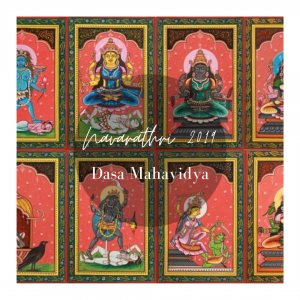
I didn’t take much time to figure out the focus for Navaratri this year, but I was indeed caught up with a lot more research than expected because this year, let’s talk about the Dasa Mahavidya : The ten forms of the Divine Mother (dasa meaning ten in Sanskrit).
Hello everyone, and thank you for wanting to read the Navaratri Nineteen series. This year’s Navaratri affair is pretty much similar to the previous years’ – I still miss being a kid. The memories of Navaratri back in my childhood are so exuberant that I still remember them as clear as sky. Today, I re-live past Navaratri celebrations with my writing ; learning and reminiscing. Forgive me if I make any account errors while trying to portray the Dasa Mahavidyas in my very own contemporary style. Forgive me, and educate me.
I pulled up a major search online about the Dasa Mahavidyas and the first word that seemingly outshone the rest was “tantric”.
When we say “tantric”, we are immediately under the grave impression that “tantric” means evil magic (cues Chanda BGM from Amman). After a bit of reading, I wouldn’t disagree but I wouldn’t agree either. Allow me to shed some light on this.
Imagine that you have a plant growing at home, stems spilling out of the clay flower pot and it grows to an alarming extent but it grows out everywhere with no proper direction. Now imagine the same plant, but it has a support structure erected in the flower pot, like a pole or a plastic grill. The plant grows towards the direction of which the structure ends, surrounding it, being supported by it and weaving through it. Now, adopt this imagery to try and decipher Tantric worship.
“Tantra” loosely means “to weave” in Sanskrit. Tantric worship is a doctrine that is “weaved” with one’s reality to led him/her into attaining a greater purpose in their lives. Tantric worship runs in parallel with Vedic worship because the latter was involved in the shaping of Hinduism itself, while the former draws practicality from Hinduism instead. In the age of Kaliyuga where it is impossible to invoke gods and goddesses from yagnas and chanting of hymn books, people turn to Tantric worship where it is easier to follow a systematic technique to attain self-enlightenment. Tantric worship however, CAN be perused in both the good and bad way and Tantric practices MUST be carried out in the presence/guidance of an experienced practitioner.
Some examples of Tantric worship involves animal sacrifices (that was also present in Vedic Worship), rituals that involve offerings in return for a response/action, yoga, etc. There are way too many branches about tantric practices, some of which could be quite a thrilling constituent in this topic of conversation, but we will save that for another day.
Now that we have defined Tantric worship, or at least managed to, the pantheon of Gods who are involved in Tantric worship includes the Dasa Mahavidya. These ten cosmic goddesses are known to be the paragon of wisdom and truth that could be attained through ritualistic methods of praying to them. Like aforementioned, it could be directed as a positive energy and a negative energy.
Over the course of the next ten days will be a contemporary take on the ten cosmic goddesses and an attempt to shine more light on them. Many amongst us follow Tantric worship in a small way or another, and to know all about it is of course, rudimentary.
As Navaratri rolls in tomorrow, today will be the day that the divine power (shakti) descends down to earth for nine nights, finally engaging in battle atmosphere on the tenth. We call this padi iranguthal, padi referring to stepsand iranguthal referring to the action of ascending. I spoke intensively about the nine forms of Durga on Navaratri last year – you can check that out on my home page!
Navaratri also welcomes the festive fervour of the annual fire walking festival held in Singapore here, which means our nine nights stretch up to eighteen nights instead while we go through a whole lot of festival zest and limitless vegetarian food. I said this last year and I will say it again – tau sambal three times a week ain’t that bad.
Happy fasting to all devotees, and a happy, colourful Navaratri to all celebrating !
